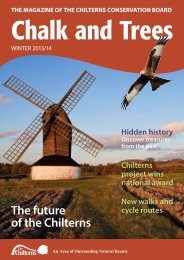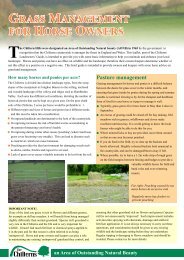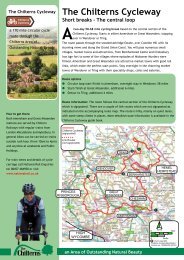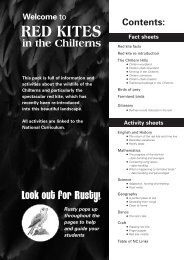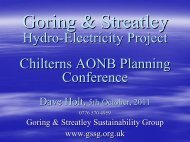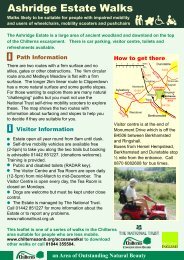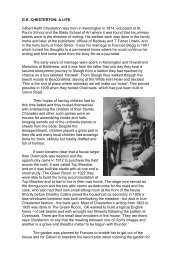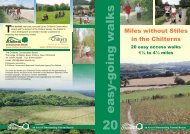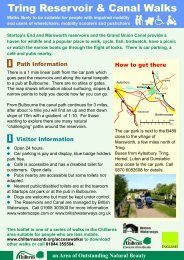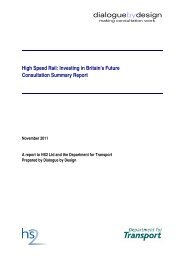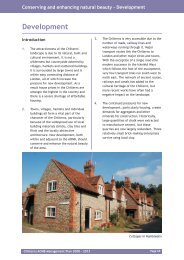Ponds - The Chilterns
Ponds - The Chilterns
Ponds - The Chilterns
- No tags were found...
Create successful ePaper yourself
Turn your PDF publications into a flip-book with our unique Google optimized e-Paper software.
PONDShe Chiltern Hills were designated an Area of Outstanding Natural Beauty (AONB) in 1965 in recognition that they are oneof the finest landscapes in England and Wales. This leaflet, part of the <strong>Chilterns</strong> Landowners’ Guide, is intended to provideTyou with some basic information to help you maintain and enhance the natural beauty of your local landscape.Why are ponds important?<strong>Ponds</strong> have an important role to play in the landscape and culturalheritage of the <strong>Chilterns</strong>. <strong>The</strong>y are a significant feature in terms of localdistinctiveness and in many areas, form a parish or village focal point.<strong>The</strong>y are also vitally important for wildlife - many rare and familiarplants and animals depend on them for at least part of their life cycle.<strong>The</strong>y provide breeding areas for frogs and toads, shelter for water volesand otters and feeding areas for bats and birds. Some rare plants such asstarfruit are only found in a few ponds in the UK. Recent research hasshown that ponds in rural landscapes often have more freshwater wildlifethan rivers, streams or ditches.<strong>The</strong>re is no standard type of pond that is best for wildlife but there are afew general things that can help make any pond a rich wildlife habitat.Management to benefit wildlifeSurprisingly, ponds withoutmuch open water are oftenvery valuable for wildlife.Resist the temptation to clearponds with large areas of siltor which dry out for part of theyear, as this can do more harmthan good to both the wildlifeand archaeology of ponds.<strong>Ponds</strong> at all stages of their An example of pond which driesout seasonally but is a superbdevelopment are valuable.habitat for wildlife includingSurrounding areas are very newts, dragonflies and toadsimportant - if possible allowdamp areas to develop aroundyour pond. This type of habitat is increasingly rare and cansupport many uncommon plants and animals. Areas of roughgrass are also good for amphibians e.g. frogs, toads and newts.If you want a pond with permanent open water then considermaking another one - never deepen or dig out existing wetlandsor wet meadows to make a new pond.Generally, a mix of water depths and bank conditions e.gshallow and steep edges will provide the best wildlife value.Potential problemsPollution - the biggest threat to most ponds. Largenumbers of fish and ducks cause problems by enriching thewater, as do fertilisers, run off from muck heaps and outflowsfrom septic tanks. <strong>The</strong>se can cause extensive growths ofduckweed and algae, choking the pond and starving it of oxygenwhich kills the inhabitants.Problem plants - non-native plants can blanket pondsurfaces and bank-sides smothering native species that supportother wildlife. Seek advice on the best way to control these ifthey appear in or near your pond.Access by grazing animals - limited grazing around partsof the pond margins and poaching of some edges is beneficial towildlife, but canalso cause problemsby stirring upsediments andincreasing the levelsof nutrients in thepond. Part fencingmay help but seekadvice on what'sbest for your pond.Shaded ponds in woods can be particularlyvaluable for wildlifean Area of Outstanding Natural Beauty
RecommendationsDon’t deepen any temporary pond to make it permanent.Leave some trees around ponds, particularly on the northside. Partial shade is important for some rare plants andanimals and may help to control some problem plants.Cleaning out a pond does just that - it cleans out thehabitat and the wildlife. Remove a little at a time taking careto leave the spoil near the pond to allow wildlife to return tothe water. If in doubt seek advice.Pond PlantsSome exotic pond plants bought from garden centresbecome very damaging pests in the countryside by spreadingto other ponds. <strong>The</strong> problem seems to be particularlyserious with submerged plants, (often called oxygenatingplants). Choose native submerged species, DON'T moveplants from garden ponds into wild ponds. Some exoticspecies are now a significant threat to some of our mostbeautiful wetlands and rarest plant species. Annually,thousands of pounds are spent trying to eradicate them.Try to avoid managing the pond in winter months whenhibernating frogs and newts could be disturbed and diethrough exposure to cold.Avoid adding plants to your pond; the best vegetation isthat which occurs naturally. If you do want to add plants onlyuse those that are native to Britain. In particular avoid thefollowing:New Zealand Swamp Stone-crop (Crassula helmsii) -sometimes called Tillea recurvaParrot's-feather (Myriophyllum aquaticum)Floating Pennywort (Hydrocotyle ranunculoides)Curly Water-thyme (Lagarosiphon major).Avoid stocking a wildlife pond with fish and ducks asthey pollute the still water and eat the other inhabitants (evenif you feed them!).Take care when using any chemicals near ponds - followthe appropriate codes of good practice.Where possible, leave an area 2-5m around your pond togrow into rough grass and small shrubs to provide habitat forbirds and amphibians and a physical barrier againstdisturbance and spray drift.Leaving piles of dead wood and large stones providesshelter and basking areas for insects and amphibians.Relevant legislationAny ponds that are a home to the Great Crested Newt, are in adesignated Site of Special Scientific Interest or are a ScheduledAncient Monument, will require permission (from the relevantbody) to be granted before any work is carried out. If you arethinking of introducing fish to a pond - contact the EnvironmentAgency www.environment-agency.gov.uk or telephone 08708506506.For free fact sheets on Good Wildlife <strong>Ponds</strong>, Planting Up <strong>Ponds</strong>and Problem Pond Plants or to order a copy of <strong>The</strong> Pond Book -contact <strong>The</strong> <strong>Ponds</strong> Conservation Trust www.pondstrust.org.ukSummary<strong>Ponds</strong> are an integral part of the <strong>Chilterns</strong>. Many are important for cultural reasons and for wildlife. Management can do more harmthan good so it is always best to take advice before starting any work.Photographs and text supplied by <strong>Chilterns</strong> Conservation Board.<strong>The</strong> <strong>Ponds</strong> Conservation Trust & Farming and Wildlife Advisory Group.FOR FURTHER INFORMATION,PLEASE CONTACTTracy AdamsFarming and Land Use Officer<strong>Chilterns</strong> Conservation Board<strong>The</strong> Lodge 90 Station RoadChinnor Oxon OX39 4HATel: 01844 355523email: tadams@chilternsaonb.orgwebsite: www.chilternsaonb.organ Area of Outstanding Natural Beauty



